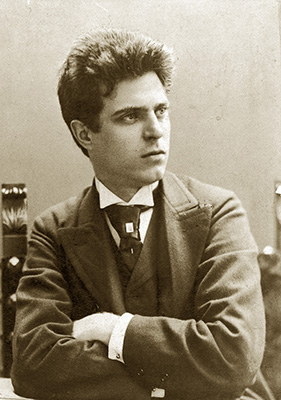On the 13th January 1910 the first public radio broadcast took place in the USA; a performance of the operas Cavalleria Rusticana and Pagliacci from the Metropolitan Opera House in New York City. It was an experiment and publicity stunt arranged by Lee de Forest, the inventor of a device called the Audion which was effectively the original radio valve and the first method of electrical amplification that actually worked.
The opera performance starred the Italian tenor Enrico Caruso. Few people actually heard the broadcast because the only radio receivers were those at the De Forest Laboratory, some hotels on Times Square and various locations in New York where members of the press optimistically waited. There were also receivers on ships in New York Harbour.
The following day, The New York Times reported breathlessly that the sounds of the opera were “borne by wireless Hertzian waves over the turbulent waters of the sea to transcontinental and coastwise ships and over the mountainous peaks and undulating valleys of the country.” Despite the poetic licence and purple prose, the sound quality wasn’t particularly good because early microphones had technical limitations and the antenna on the roof of the opera house was evidently no more than a long fishing pole. Or so the story goes.
The two short operas Cavalleria Rusticana and Pagliacci have been conjoined since 1893 when they were paired for a performance – also at the Metropolitan – and usually known as Cav and Pag. Both were conceived in the novel verismo (realistic) style of opera which instead of using mythological themes and tales of kings and queens, told stories about ordinary people, usually enlivened with a bit of sex and violence.
Mascagni’s opera Cavalleria Rusticana (“Rustic Chivalry”) caused one of the greatest sensations in opera history. It came about because of a competition. In July 1888 a music publisher in Milan announced an opera competition open to all young Italian composers whose work was unperformed. Pietro Mascagni (PYAY-troh mah-SKAHN-yee) heard about it only a couple of months before the closing date and hastily got to work using a libretto based on a story set in a Sicilian village.

Cavalleria Rusticana was probably the first opera in the verismo style and was premiered in 1890 to an audience of the most authoritative music critics in the country. With its rich melodies and powerful dramatic style it was an enormous success, requiring the composer to take forty curtain calls. He also won First Prize in the competition. It brought Mascagni fantastic success both as a composer and conductor. None of his later works ever managed to eclipse this opera which by the composer’s death had received fourteen thousand performances in Italy alone.
The beautiful and moving Intermezzo is one of most well-known instrumental pieces from the opera. The Evergreen Symphony Orchestra is from Taiwan and part of the Evergreen Group which also owns EVA Air. If you take an EVA flight, you’ll probably hear recordings of this orchestra playing the background music during boarding and landing.
Now here’s a real treat if you have an hour to spare. In 1982, Franco Zeffirelli made a TV movie of the opera shot in Milan’s La Scala opera house and on a sound stage. All the actors, including Plácido Domingo and Teresa Stratas in the starring roles, sang their own parts. The video quality isn’t so good by today’s standards, but otherwise this is a compelling production with subtitles in English.
Although Leoncavallo’s opera was originally set in the late 1860s, Zeffirelli’s production is updated to sometime between the wars. Zeffirelli also made a TV movie of Cavalleria Rusticana with much the same cast and many sequences shot on location. You can find it on YouTube but there are no subtitles.
Before writing this opera, Ruggero Leoncavallo was a relatively unknown Italian composer but he was impressed with the enormous success of Cavalleria Rusticana and hastily got to work on his own new opera also in the verismo style. Pagliacci (Pah-lee-AH-chee) was performed in Milan in 1892 with immediate success. Although the composer produced numerous operas throughout his career Pagliacci (“The Clowns”) is his only work in today’s operatic repertoire. The plot was based on an incident from his childhood; a true-life murder trial over which his father, who was a judge, had presided in court.
The opera is a cleverly designed story-within-a-story and recounts a tragedy that takes place in a travelling comedy troupe. What starts as seemingly innocent clowning turns jealousy to rage and then inevitably to a dramatic double murder.
To watch these YouTube videos, either use your Smartphone to read the QR codes or go to this article online, click on the “live” links and go direct to the videos. If you have a laptop, sound quality can be improved significantly by using headphones or external speakers.
 |
 |
 |





